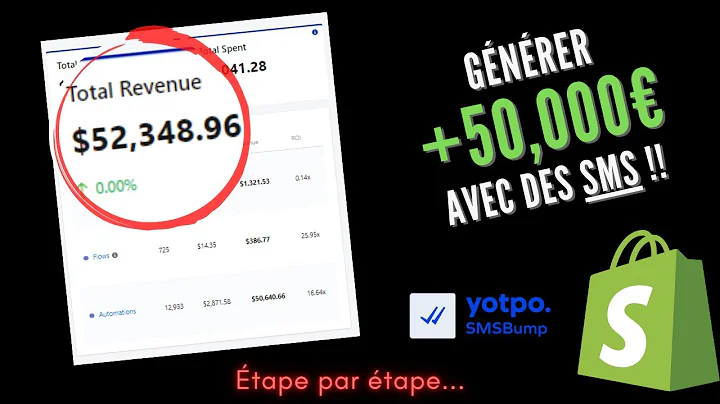Optimiser Meta Tags Shopify
Table of Contents:
- Introduction
- Importance of Optimizing Meta Tags
- Understanding Title Tags
- 3.1 The role of the title tag
- 3.2 Best practices for optimizing title tags
- 3.3 Examples of optimized title tags
- Understanding Meta Descriptions
- 4.1 The purpose of meta descriptions
- 4.2 Tips for writing effective meta descriptions
- 4.3 Examples of well-written meta descriptions
- Visual Representation of Meta Tags in Search Engines
- Integrating Meta Tags in the Source Code
- Optimizing Meta Tags on Shopify
- 7.1 Optimizing meta tags on product pages
- 7.2 Optimizing meta tags on blog articles
- 7.3 Optimizing meta tags on the homepage
- Tips for Optimizing Title Tags
- 8.1 Avoiding keyword stuffing
- 8.2 Incorporating long-tail keywords
- 8.3 Determining the optimal title tag length
- Importance of Relevance and User Engagement
- 9.1 Aligning meta tags with content
- 9.2 Factors affecting user engagement
- Conclusion
Optimizing Meta Tags for Better Search Visibility
Introduction
Optimizing meta tags is a crucial part of search engine optimization (SEO) strategy. Title tags and meta descriptions play a vital role in improving search visibility, attracting users to click on your website, and increasing organic traffic. In this article, we will explore the importance of optimizing meta tags and provide practical tips to help you create compelling title tags and meta descriptions.
Importance of Optimizing Meta Tags
Meta tags are HTML elements that provide information about a web page to search engines. While meta descriptions do not directly impact search engine rankings, they are crucial for enticing users to click on your website when it appears in search results. On the other hand, title tags have a significant impact on both search rankings and user engagement.
Understanding Title Tags
The role of the title tag
The title tag is the most important element for SEO within the head section of a web page. It acts as a concise summary of the content and helps search engines understand the context of the page. Including relevant keywords in the title tag is crucial for optimizing it.
Best practices for optimizing title tags
To optimize title tags, it is essential to follow best practices such as incorporating primary keywords, making them unique and descriptive, and keeping them within the recommended character limit. Additionally, using engaging language and including branding elements can make your title tags more appealing to users.
Examples of optimized title tags
For a better understanding, let's consider some examples of well-optimized title tags:
- "Best Pancake Molds for Perfect Breakfasts - Silicone Pancake Molds"
- "Create Delicious Pancakes with Our Non-Stick Silicone Molds - Shop Now"
- "Explore a Variety of Pancake Molds - High-Quality and Durable"
Understanding Meta Descriptions
The purpose of meta descriptions
Meta descriptions provide a concise summary of the web page's content in search engine results pages (SERPs). Although they do not directly affect rankings, well-written meta descriptions can significantly impact click-through rates (CTR) and user engagement.
Tips for writing effective meta descriptions
To create compelling meta descriptions, it's crucial to include relevant keywords, highlight unique selling points, and use persuasive language to encourage users to click on your website. Keeping meta descriptions within the ideal character limit and avoiding duplicate content is also important.
Examples of well-written meta descriptions
Let's take a look at some examples of effective meta descriptions:
- "Discover the latest pancake molds that make breakfasts a breeze. Our high-quality silicone molds ensure perfect pancakes every time. Shop now and elevate your breakfast experience."
- "Looking for non-stick pancake molds? Browse our selection of durable and easy-to-use silicone molds. Enhance your pancake cooking skills with our premium product range."
- "Explore our collection of pancake molds for making creative and unique pancakes. From animal shapes to emoji patterns, our molds will take your pancake game to the next level."
Visual Representation of Meta Tags in Search Engines
In this section, we will explore how title tags and meta descriptions are visually presented in search engine results pages (SERPs). Understanding their visual appearance will help you craft more effective and engaging meta tags.
Integrating Meta Tags in the Source Code
To understand how title tags and meta descriptions are integrated into the source code of web pages, we will take a closer look at the HTML structure. Knowing where to include these meta tags is crucial for optimizing them.
Optimizing Meta Tags on Shopify
On Shopify, optimizing meta tags involves customizing the title tags and meta descriptions for various pages, including product pages, blog articles, and the homepage. This section will provide step-by-step instructions for optimizing meta tags on your Shopify store.
Tips for Optimizing Title Tags
To ensure your title tags are optimized, there are several tips to keep in mind. These include avoiding keyword stuffing, incorporating long-tail keywords, and determining the optimal title tag length based on best practices and specific search intent.
Importance of Relevance and User Engagement
It is crucial to align your meta tags with the content of your web pages. Ensuring that the meta description accurately represents the information users will find on the page reduces the bounce rate and increases user engagement. Various factors, such as page load speed, mobile optimization, and compelling content, contribute to user engagement and the overall success of your SEO efforts.
Conclusion
Optimizing meta tags, including title tags and meta descriptions, is an essential aspect of SEO. By following best practices and ensuring relevance and user engagement, you can improve your website's visibility in search engine results, attract more organic traffic, and ultimately drive conversions. Remember to regularly analyze and update your meta tags to stay ahead in the competitive online marketplace.






















